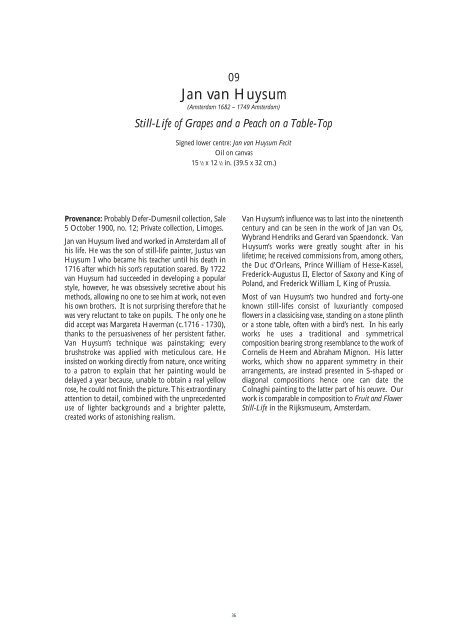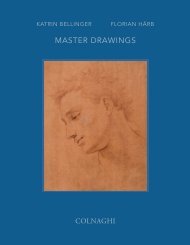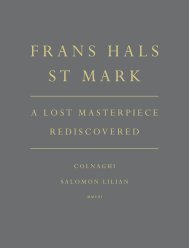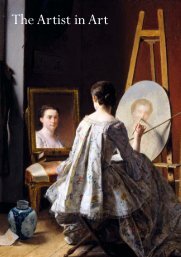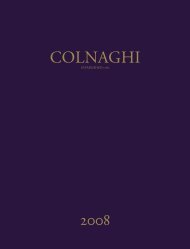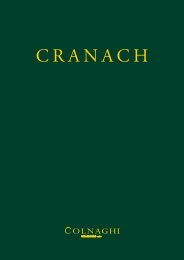2007 Catalogue - Colnaghi
2007 Catalogue - Colnaghi
2007 Catalogue - Colnaghi
Create successful ePaper yourself
Turn your PDF publications into a flip-book with our unique Google optimized e-Paper software.
Provenance: Probably Defer-Dumesnil collection, Sale<br />
5 October 1900, no. 12; Private collection, Limoges.<br />
Jan van Huysum lived and worked in Amsterdam all of<br />
his life. He was the son of still-life painter, Justus van<br />
Huysum I who became his teacher until his death in<br />
1716 after which his son’s reputation soared. By 1722<br />
van Huysum had succeeded in developing a popular<br />
style, however, he was obsessively secretive about his<br />
methods, allowing no one to see him at work, not even<br />
his own brothers. It is not surprising therefore that he<br />
was very reluctant to take on pupils. The only one he<br />
did accept was Margareta Haverman (c.1716 - 1730),<br />
thanks to the persuasiveness of her persistent father.<br />
Van Huysum’s technique was painstaking; every<br />
brushstroke was applied with meticulous care. He<br />
insisted on working directly from nature, once writing<br />
to a patron to explain that her painting would be<br />
delayed a year because, unable to obtain a real yellow<br />
rose, he could not finish the picture. This extraordinary<br />
attention to detail, combined with the unprecedented<br />
use of lighter backgrounds and a brighter palette,<br />
created works of astonishing realism.<br />
09<br />
Jan van Huysum<br />
(Amsterdam 1682 – 1749 Amsterdam)<br />
Still-Life of Grapes and a Peach on a Table-Top<br />
Signed lower centre: Jan van Huysum Fecit<br />
Oil on canvas<br />
15 1 /2 x 12 1 /2 in. (39.5 x 32 cm.)<br />
36<br />
Van Huysum’s influence was to last into the nineteenth<br />
century and can be seen in the work of Jan van Os,<br />
Wybrand Hendriks and Gerard van Spaendonck. Van<br />
Huysum’s works were greatly sought after in his<br />
lifetime; he received commissions from, among others,<br />
the Duc d’Orleans, Prince William of Hesse-Kassel,<br />
Frederick-Augustus II, Elector of Saxony and King of<br />
Poland, and Frederick William I, King of Prussia.<br />
Most of van Huysum’s two hundred and forty-one<br />
known still-lifes consist of luxuriantly composed<br />
flowers in a classicising vase, standing on a stone plinth<br />
or a stone table, often with a bird’s nest. In his early<br />
works he uses a traditional and symmetrical<br />
composition bearing strong resemblance to the work of<br />
Cornelis de Heem and Abraham Mignon. His latter<br />
works, which show no apparent symmetry in their<br />
arrangements, are instead presented in S-shaped or<br />
diagonal compositions hence one can date the<br />
<strong>Colnaghi</strong> painting to the latter part of his oeuvre. Our<br />
work is comparable in composition to Fruit and Flower<br />
Still-Life in the Rijksmuseum, Amsterdam.


